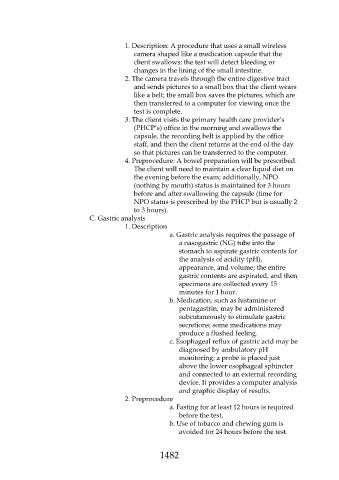Page 1482 - Saunders Comprehensive Review For NCLEX-RN
P. 1482
1. Description: A procedure that uses a small wireless
camera shaped like a medication capsule that the
client swallows; the test will detect bleeding or
changes in the lining of the small intestine.
2. The camera travels through the entire digestive tract
and sends pictures to a small box that the client wears
like a belt; the small box saves the pictures, which are
then transferred to a computer for viewing once the
test is complete.
3. The client visits the primary health care provider’s
(PHCP’s) office in the morning and swallows the
capsule, the recording belt is applied by the office
staff, and then the client returns at the end of the day
so that pictures can be transferred to the computer.
4. Preprocedure: A bowel preparation will be prescribed.
The client will need to maintain a clear liquid diet on
the evening before the exam; additionally, NPO
(nothing by mouth) status is maintained for 3 hours
before and after swallowing the capsule (time for
NPO status is prescribed by the PHCP but is usually 2
to 3 hours).
C. Gastric analysis
1. Description
a. Gastric analysis requires the passage of
a nasogastric (NG) tube into the
stomach to aspirate gastric contents for
the analysis of acidity (pH),
appearance, and volume; the entire
gastric contents are aspirated, and then
specimens are collected every 15
minutes for 1 hour.
b. Medication, such as histamine or
pentagastrin, may be administered
subcutaneously to stimulate gastric
secretions; some medications may
produce a flushed feeling.
c. Esophageal reflux of gastric acid may be
diagnosed by ambulatory pH
monitoring; a probe is placed just
above the lower esophageal sphincter
and connected to an external recording
device. It provides a computer analysis
and graphic display of results.
2. Preprocedure
a. Fasting for at least 12 hours is required
before the test.
b. Use of tobacco and chewing gum is
avoided for 24 hours before the test.
1482

